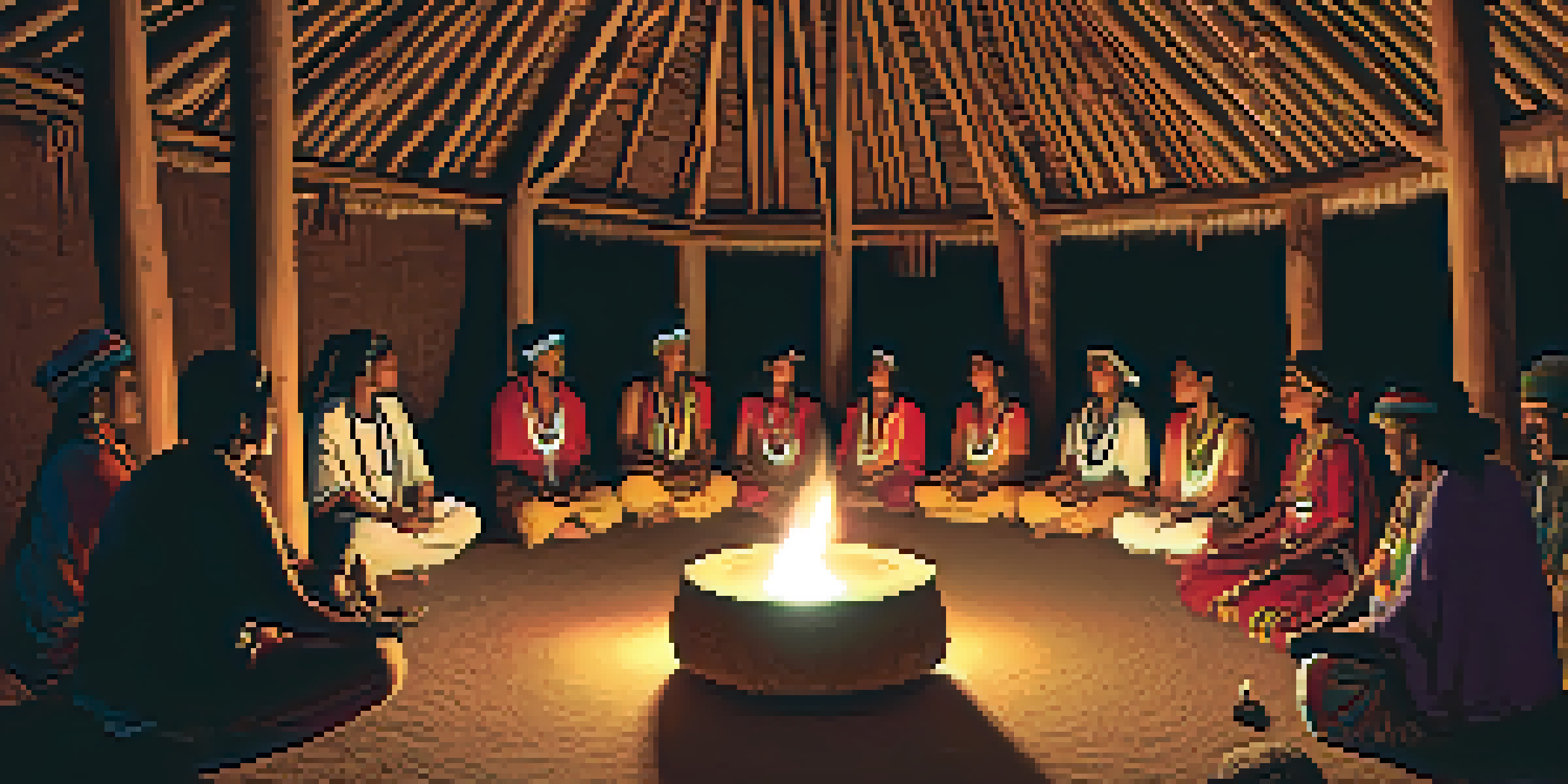Ayahuasca and Deforestation: A Growing Concern for Biodiversity

Understanding Ayahuasca and Its Cultural Significance
Ayahuasca, a powerful plant-based brew, has deep roots in Amazonian cultures. Traditionally used in spiritual ceremonies, it embodies the connection between nature and human experience. Many indigenous communities believe that ayahuasca offers profound insights, healing, and guidance, making it essential to their cultural practices.
In nature's economy, the currency is not money, but life.
As its popularity has surged globally, so too has the demand for its key ingredients, primarily the ayahuasca vine and other plants. This demand has led to increased harvesting in the wild, which raises concerns about sustainability. While ayahuasca rituals can be transformative, the environmental impact of its production is often overlooked.
Understanding this cultural significance is crucial as we navigate the growing interest in ayahuasca. It highlights the need to balance spiritual practices with ecological responsibility. After all, the health of the Amazon directly influences the well-being of countless species, including humans.
The Link Between Ayahuasca and Deforestation
The rise in ayahuasca consumption has created a direct link to deforestation as demand for the plants increases. Unsustainable harvesting practices are often employed, leading to significant loss of biodiversity in the Amazon rainforest. This not only threatens the plants used in the brew but also the myriad of species that rely on this ecosystem.

Deforestation due to ayahuasca production is often overlooked when discussing environmental issues. While agricultural expansion and logging are commonly cited culprits, the growing market for ayahuasca adds another layer of complexity. It’s crucial to recognize that every cup of ayahuasca consumed can have far-reaching ecological consequences.
Cultural Significance of Ayahuasca
Ayahuasca serves as a vital spiritual tool for Amazonian cultures, offering healing and insights while emphasizing the connection between nature and human experience.
Addressing this issue requires awareness and proactive measures from both consumers and producers. Sustainable harvesting practices and the cultivation of ayahuasca ingredients are vital to mitigate deforestation. Without these efforts, the delicate balance of biodiversity in the Amazon is at risk.
Biodiversity and Its Importance to Ecosystems
Biodiversity refers to the variety of life forms within an ecosystem, including plants, animals, and microorganisms. It plays a crucial role in maintaining ecological balance, providing essential services such as pollination, water purification, and climate regulation. The Amazon rainforest is one of the most biodiverse regions on the planet, making its preservation vital for global health.
The clearest way into the Universe is through a forest wilderness.
When deforestation occurs, not only do we lose species, but we also disrupt these essential services. For example, the loss of certain plant species can lead to declines in pollinators, which affects food production. This interconnectedness highlights why preserving biodiversity is not just about saving individual species—it's about maintaining the health of the entire planet.
In the context of ayahuasca, the loss of biodiversity can mean the loss of the very ingredients that make this brew special. Protecting the rainforest ensures that future generations can continue to experience the cultural and spiritual benefits of ayahuasca without compromising the ecosystem.
Sustainable Practices in Ayahuasca Production
As the awareness of the environmental impacts grows, there is a push for sustainable practices in ayahuasca production. This includes cultivating ayahuasca plants in controlled environments rather than harvesting them from the wild. Such practices not only help preserve the rainforest but also ensure a steady supply of ingredients for future use.
Organizations and initiatives are emerging that promote sustainable harvesting techniques among indigenous communities. By training local farmers in sustainable methods, they can meet the demand for ayahuasca without contributing to deforestation. This approach fosters an economic incentive for conservation, benefiting both the environment and local livelihoods.
Deforestation Linked to Demand
The rising global demand for ayahuasca contributes to deforestation, threatening biodiversity and the very plants used in its production.
Moreover, consumers can play a role by choosing to support brands and practitioners that prioritize sustainability. By making informed choices, individuals can help create a demand for environmentally friendly practices in the ayahuasca market, ultimately contributing to the preservation of biodiversity.
The Role of Education in Sustainable Ayahuasca Practices
Education is a powerful tool in promoting sustainable practices in ayahuasca production. By increasing awareness of the ecological impacts of deforestation, consumers and producers alike can make informed decisions. Workshops and seminars can help share knowledge about sustainable harvesting methods and the importance of biodiversity.
Additionally, educating consumers about the origins of their ayahuasca can foster a deeper connection to the environment. Understanding the journey from plant to brew can instill a sense of responsibility, encouraging individuals to seek out ethically sourced ayahuasca. This cultural shift can be pivotal in changing the dynamics of production.
Ultimately, education creates a ripple effect, inspiring individuals to advocate for sustainable practices in their communities. As more people become aware of the environmental implications of their choices, the collective effort can lead to significant change in the ayahuasca industry.
Global Efforts to Combat Deforestation
Combatting deforestation requires a coordinated global effort, and various organizations are working tirelessly toward this goal. Initiatives aimed at rainforest conservation often intersect with efforts to support indigenous communities, recognizing their role as stewards of the land. These partnerships can yield effective strategies for preserving biodiversity while respecting cultural practices.
Reforestation projects are also gaining traction, aiming to restore areas that have been degraded by deforestation. By reintroducing native plant species, these projects help rebuild ecosystems and promote biodiversity. Such efforts are essential not only for the health of the Amazon but also for combating climate change on a global scale.
Importance of Sustainable Practices
Promoting sustainable harvesting and cultivation of ayahuasca ingredients is crucial for balancing ecological health with cultural practices.
Moreover, international cooperation is crucial in addressing the complex issues surrounding deforestation tied to ayahuasca production. By sharing knowledge, resources, and best practices, countries can work together to protect this vital ecosystem for future generations.
Moving Forward: Balancing Spirituality and Sustainability
As the interest in ayahuasca continues to grow, finding a balance between spirituality and sustainability becomes imperative. The health of the Amazon rainforest is intricately linked to the spiritual practices that many seek through ayahuasca. Therefore, it’s vital that these practices evolve to incorporate environmental consciousness.
Encouraging sustainable practices within the ayahuasca community can lead to a richer experience for all involved. When participants understand the ecological impact of their actions, they can engage more fully with the spiritual journey of ayahuasca. This holistic approach fosters a deeper respect for nature and its resources.

In conclusion, by prioritizing sustainability in ayahuasca production, we can preserve both the cultural significance of this brew and the rich biodiversity of the Amazon rainforest. The journey ahead requires collaboration, education, and a commitment to protecting our planet.